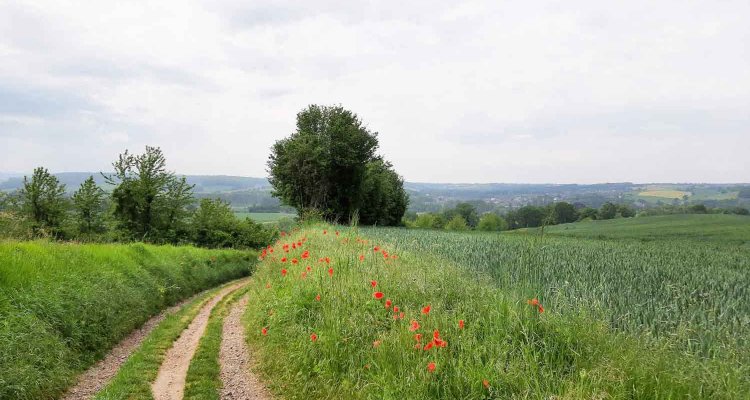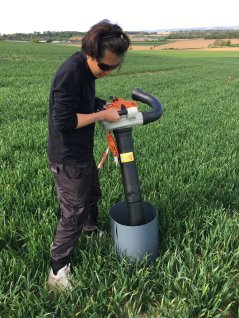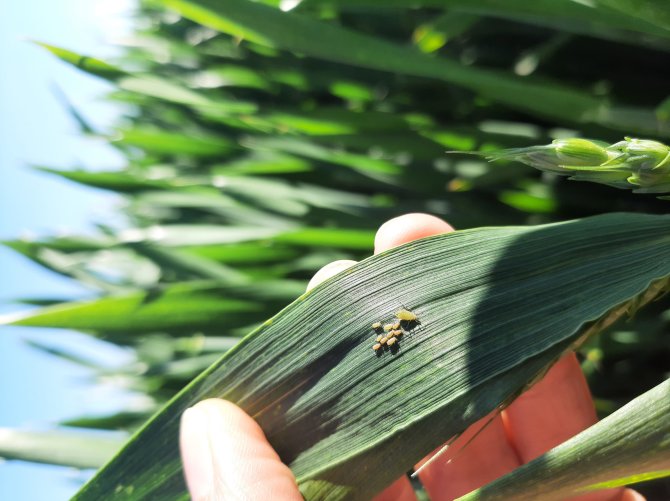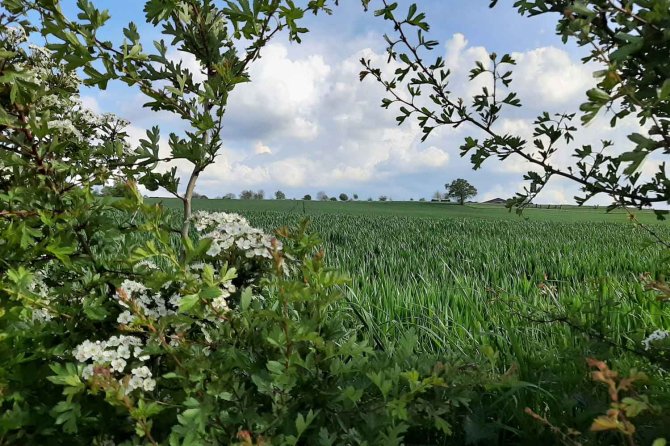
Feeling biodiversity in the farmer’s pocket
How can the nature value of farmland be boosted so that it becomes attractive again for insects and birds, but without farmers feeling the pinch in their pockets? WUR ecologist David Kleijn will search for the answer to this very question in the coming few years. “If we want farmers to switch to extensive farming, then they should receive compensation for that.”
It won’t make the headlines, but the shrill carder bumblebee is back in the Netherlands. The insect had been wiped out, but two students of David Kleijn, professor of Ecology at Wageningen University & Research, caught one in their insect net in the Geul valley. It is a sign of the improvement in the quality of the countryside between Valkenburg and Gulpen.
Those costs could well be the reason why so few farmers do anything about biodiversity
David Kleijn has been studying biodiversity in the Geul valley for years. Now, as the leader of the European research project SHOWCASE, he is involving local farmers in that project. Biodiversity is crucial in conserving ecosystems, but the number of different species is declining rapidly around the world. In the Netherlands alone, butterfly populations have fallen by 70 per cent in the past century. A similar picture is seen for birds typically found in farmland. Intensive agricultural practices are one reason for the decrease in biodiversity.
Cost-benefit

In South Limburg, Kleijn wants to investigate what is needed to make biodiversity an integral part of farming practices. Kleijn believes that researchers have spent too long looking exclusively at the ecological side of biodiversity. “We showed the benefits, for example the higher yields if you have more bees to pollinate your apples or sunflowers.
But we always ignored the costs for farmers. Those costs could well be the reason why so few farmers do anything about biodiversity on their farms. Of course there are pioneers, the farmers who everyone is full of praise for. But they do it for a different reason: they are really interested in developing an alternative approach to farming that will boost biodiversity.”
Kleijn says the average farmer goes with the flow. They take out a loan with a bank. “The farmer then has to farm the land intensively, looking for economies of scale and using lots of fertiliser and crop protection agents, to be able to pay the interest on the loan and keep up with the repayments. In other words, they end up doing all the things that are bad for biodiversity.” That is the driving force behind the whole system, says Kleijn. He is convinced that if you asked individual farmers, they would be willing to take a different approach, but they feel forced to produce as much as possible for financial reasons when the price of land is 80,000 euros per hectare.
Mental shift
Measures to increase biodiversity therefore require changes to the land management and business operations at the same time. “If you plant a strip of land with flowers to attract bees, hoverflies, butterflies and ladybirds, that’s land you can’t use for crops. You may even need to adapt your machinery. Those are all costs and even if it makes financial sense, it still requires a mental shift. I realise only too well how difficult this is.”
If we want farmers to switch to extensive farming, they need to be compensated for the extra costs
The SHOWCASE project investigates the financial implications for farmers when promoting biodiversity becomes a regular aspect of the farming business. Kleijn is studying the case of grassland in the Geul valley. “From farms with standard perennial ryegrass to farms with grassland rich in species on Vrakelberg hill. We cover the entire spectrum in the intensity of grassland management.”
Plots with perennial ryegrass are mown up to five times a year. The grass is rich in protein and can be fed to cows directly. That leads to milk with high concentrations of fat and protein. Highly biodiverse grassland, on the other hand, is mown less frequently and has a lower protein content. Farmers therefore have to buy in extra feed if they are to produce milk with sufficient concentrations of fat and protein. The project investigates the costs involved.
“At the same time, we’re surveying the biodiversity of the vegetation, both the fertilised plots with ryegrass and the species-rich grass on Vrakelberg, where orchids grow, for example. We are measuring the numbers and species of plants, bees and earthworms. But we are also looking at carbon sequestration and nitrogen leaching — after all, it is vital for the delicate landscape of the Geul valley to retain the nitrogen.”

Public goods
An attractive agricultural landscape with flowers, buzzing insects, ditches with clear water that contain frogs and newts, copses and brushwood: these are all examples of ‘public goods’. We enjoy them as we cycle past, stop for a picnic or survey the scenery from our living room window. Such ‘ecosystem services’, as they are termed, are important. “But these are all things that cost farmers effort without them getting a penny in return, making it perfectly logical for a farmer to say, ‘Fine if you want me to do that, but I also want to be paid for it’. So if we want farmers to switch to extensive farming, they will need to be compensated for the extra costs. It will be much easier to have a public debate about that once we have a good picture of these costs.”
I hope SHOWCASE will let us develop business models that incorporate biodiversity
That requires input not just from farmers but also from the major buyers. Unilever, for example, is looking for a clear-cut method for rewarding producers for measures they take to boost biodiversity. “I know farmers are interested too,” says Kleijn, “but there’s still a large financial gap. I hope SHOWCASE will let us develop business models that incorporate biodiversity.”
The KennisOnline magazine
KennisOnline magazine showcases research projects at Wageningen University & Research (WUR) that are co-funded by the Dutch Ministry of Agriculture, Nature and Food Quality. In this year’s edition, you’ll read all about how mini intestines can replace test animals, why nature-inclusive construction will become the norm, how smart farming helps pig farmers, how the small hive beetle leaves a big impact and how the public views nature.
Reducing pesticide
The SHOWCASE project sites are spread across Europe. Each country has its own specific focus. In France and Switzerland, researchers are looking at the effects of reducing pesticide use. The focus in Hungary is on the biodiversity effects of plots where strips are sown with flowers.

Kleijn’s colleagues in Spain had to talk until they were blue in the face to persuade fruit growers that putting green cover crops between the trees is a good thing because it attracts insects that serve as a natural pest control. “The farmers think weeds between the trees actually increase the risk of pests. That is why Spanish orchards are always so incredibly bare. We now have fifteen farms where small sections of the orchards are sown with green cover crops. We will be measuring which insects are found there, whether the fruit is more affected by pests or less, whether the fruits are larger or smaller and what happens to the yields. We will assess the results after two harvests.”
Lupins
The project in the Geul valley involves not just measurements in grassland but also experimenting with lupins as an alternative crop. These flowers attract a lot of insects and are beneficial for pollinators. The plant itself binds nitrogen in the soil and does not require fertiliser. What is more, the lupin seeds are full of protein and fibre. The seeds of the blue lupin are used as animal feed while the white lupin seeds can be incorporated in meat substitutes or used to make unusual dishes in restaurants.
That financial incentive makes the difference; it pushes farmers to grow the crop
Kleijn sees this crop as offering a potentially viable business model for farmers. It would also help if the government encouraged the crop by subsidising the cultivation of lupin. “Look at rapeseed. It’s a visually pleasing crop, plus it attracts a lot of insects. Germany and the United Kingdom are full of rapeseed as it is heavily subsidised for the production of biodiesel. That financial incentive makes the difference; it pushes farmers to start growing the crop.”
- Unfortunately, your cookie settings do not allow videos to be displayed. - check your settings
You can’t think green if you are in the red, if you ask Dutch farmers. So how can you motivate them to still integrate biodiversity in their agricultural businesses – especially in a country where every square metre of land is carefully controlled, thus coming with a price tag when making changes? That’s the question David Kleijn, ecologist at Wageningen University & Research, intends to answer. (UK subtitles available in the video).